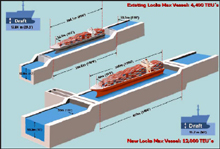Science prof recounts trip to Panama Canal

 The Panama Canal is being rebuilt on a grand scale, one that civil engineers are eager to see for themselves, said OCCC physical science Professor Gary Houlette in a speech on campus in February.
The Panama Canal is being rebuilt on a grand scale, one that civil engineers are eager to see for themselves, said OCCC physical science Professor Gary Houlette in a speech on campus in February.
Houlette talked about his recent trip with fellow engineers to the construction site.
He said part of the challenge involves moving giant ships through different water levels as they sail through the waterway that links the Pacific and Atlantic oceans.
A lock-and-dam system is used to accommodate the 60-foot difference in height that ships encounter when traversing the canal.
The new locks will be 1,400 feet long, and 180 feet wide, and a new lane is to be added, Houlette said.
The system works with a series of gates, he said. One gate closes, a reservoir fills, the ship is raised, and another gate opens. A ship may be raised or lowered, using the locks. A reservoir may be drained to lower a ship or filled to raise it.
Houlette said the cost of the project is estimated at $5.25 billion. He showed pictures from his trip to illustrate the extreme scale of its expansion.
“We were like kids in a candy store,” he said, referring to himself and his engineering partners who made the trip.
He devoted 30 minutes to the history of the Panama Canal and the engineering challenges that went with it, from the initial failures of the French to the grandstanding of President Theodore Roosevelt when the project was finally completed in 1914.
When building the first rendition of the Panama Canal, one of the most difficult challenges came from yellow fever.
Houlette said thousands died from yellow fever before they engineered a solution: spraying every puddle of water for miles around with a thin layer of oil, preventing the mosquitoes which carry it from breeding.
Houlette explained that the French failed to devise a lock-and-dam system, aiming for a straight channel across the country, resulting in failure before the site was bought out by Americans.
Panama “liberated” itself from Columbia with American help, and innovations in steam shovel technology made the necessary excavations possible.
Houlette said he was delighted to announce this is his 30th year teaching at OCCC. He kicked off the presentation by bragging on his students and the engineering program he’s helped establish.
He said he has taught calculus, physics, statics, thermodynamics, electrical circuits, dynamics and materials, along with classes in his dedicated fabrication area.
Houlette thanked the Engineering Club for providing refreshments, and the Oklahoma Society of Professional Engineers for attending his presentation.
For more information, contact Houlette at 405-682-1611, ext. 7272, or ghoulette@occc.edu.
To contact Grant Swalwell, email onlineeditor@occc.edu